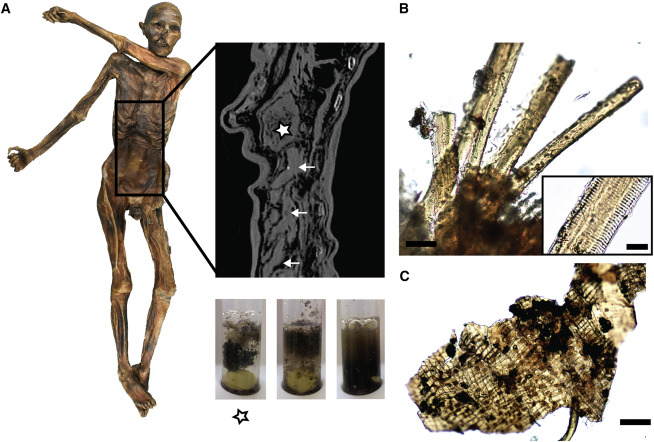
An ancient frozen European Copper Age mummy, which was died almost 5,300 years ago in the Alps had something interesting inside his shrank body, which was discovered by the scientists recently. Years after discovering the body, researchers found the remains of the last meal, which the deceased had exactly before his death.
The unknown man who called as Oetzi the Iceman has provided historical evidence of the usual food that ancient Europeans used to have thousands of years ago. This research was published in the journal Current Biology, where scientists clearly noted down what they had found inside his stomach.
The findings suggested that Oetzi ate the fat and meat of a wild goat, meat of a red deer and whole wheat seeds. The researchers also discovered the traces of fern leaves and spores. As per the study authors, it is possible that the man unintentionally ate swallowed the plant, or maybe he consumed it as a medication for the parasites, which were found inside the stomach.
Frank Maixner, a microbiologist at the Institute for Mummy Studies in Bolzano, Italy and the lead author addressed it as an "impressive" finding and said that the chunks and pieces of food can be seen with the naked eyes.
Earlier, scientists have analysed Oetzi's intestines but their first attempt to look into the stomach was not only successful but also very exciting, as they found the last meal had by the frozen man.
Even though the digestion varies between different individuals and men and women, usually after eating food, it takes six to eight hours to move through the stomach, small intestine and the large intestine for the further digestion. But, for Oetzi the digestion process could not proceed further.
The deceased was found near the Italy-Austria border and almost 18-years later after the discovery, a radiologist detected the remains of food behind the rib cage and saw that it was full. The research team defrost the body and took the samples of the food, which was found inside.
Maixner said that where the body was found that place has a very harsh environment. In addition, the author said, "They had to be prepared. They had to have food that gave them the necessary energy (to survive)."
An expert in archaeozoology from the University of Oslo, Albina Hulda Palsdottir claimed that the findings are very vulnerable. He also mentioned that the researchers are trying to use all the methods to answer the really important question that during the ancient era what people actually used to eat. In addition, he also said, "Oetzi is always interesting. He's already told us so much."
However, now the lead researcher of the study including his entire team is focusing to reconstruct the composition of bacteria and other microorganisms that the scientists have found inside Oetzi's stomach.









